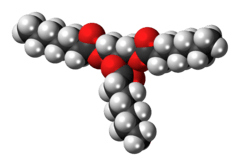Triheptanoin
 | |
 | |
| Names | |
|---|---|
| IUPAC name
1,3-Di(heptanoyloxy)propan-2-yl heptanoate | |
| Identifiers | |
| 620-67-7 | |
| 3D model (Jmol) | Interactive image |
| ECHA InfoCard | 100.009.681 |
| PubChem | 69286 |
| |
| Properties | |
| C24H44O6 | |
| Molar mass | 428.60 g/mol |
| Except where otherwise noted, data are given for materials in their standard state (at 25 °C [77 °F], 100 kPa). | |
| | |
| Infobox references | |
Triheptanoin is a triglyceride that is composed of three seven-carbon fatty acids. These odd-carbon fatty acids are able to provide anaplerotic substrates for the TCA cycle. Triheptanoin is used clinically in humans to treat inherited metabolic diseases, such as pyruvate carboxylase deficiency and carnitine palmitoyltransferase II deficiency. It also appears to increase the efficacy of the ketogenic diet as a treatment for epilepsy.
Since triheptanoin is composed of odd-carbon fatty acids, it can produce ketone bodies with five carbon atoms, as opposed to even-carbon fatty acids which are metabolized to ketone bodies with four carbon atoms. The five-carbon ketones produced from triheptanoin are beta-ketopentanoate and beta-hydroxypentanoate. Each of these ketone bodies easily crosses the blood–brain barrier and enters the brain.
References
- de Almeida Rabello Oliveira M, da Rocha Ataíde T, de Oliveira SL, et al. (March 2008). "Effects of short-term and long-term treatment with medium- and long-chain triglycerides ketogenic diet on cortical spreading depression in young rats". Neurosci. Lett. 434 (1): 66–70. doi:10.1016/j.neulet.2008.01.032. PMID 18281154.
- Mochel F, DeLonlay P, Touati G, et al. (April 2005). "Pyruvate carboxylase deficiency: clinical and biochemical response to anaplerotic diet therapy". Mol. Genet. Metab. 84 (4): 305–12. doi:10.1016/j.ymgme.2004.09.007. PMID 15781190.